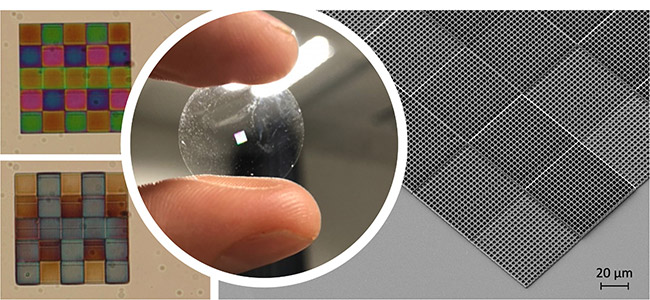
Microscopic 3D-Printed Sensors Respond to Air Chemistry with Visible Changes
Using direct laser writing (DLW) and optically responsive polymers, researchers at Trinity College Dublin and the Advanced Materials and Bioengineering Research Centre (AMBER) built miniature photonic sensors that change color in response to solvent vapors in the air. The Dublin team collaborated with Radislav Potyrailo, a principal scientist at GE Research in Niskayuna, N.Y.
The microscopic photonic arrays are capable of a reversible response to vapors, including isopropanol, ethanol, and water vapors. Their photonic response is dynamic and can be programmed and controlled at the nanoscale.
Additionally, the optically responsive sensors could represent a new role for photonic structural coloration. At the practical level, the sensors could provide a low-cost way to monitor air quality in homes in real time, and could be integrated into wearable devices for monitoring health.
The research team developed the polymers that were used to fabricate the photonic structures, and the designs for different structures, in house. “The research we carry out between the two groups focuses on design, modeling, and fabrication of these tiny structures in stimuli-responsive materials,” professor Louise Bradley said. Jing Qian, a researcher in Bradley’s lab, develops designs that can elicit different responses to stimuli.
In experiments, the team found that the periodic structures in the photonic array swelled reversibly when they were in the presence of solvent vapors. The researchers further found that the structures generated a measurable optical response that could be determined by the polarity of the solvent.
Optical microscopy images of the arrays showed vibrant, transmitted colors and changes that occurred as the structures increased in height.
Using finite-difference time-domain (FDTD) analysis, the researchers confirmed that the color and wavelength changes in the sensors correlated with changes in the dimensions of the structures in real time.
The optical response of the arrays to gas vapors, and their subsequent change in color, is like the way that some natural materials respond to light diffraction.
“More than 300 years ago, Robert Hooke first investigated the vibrant colors on a peacock’s wing. Only centuries later did scientists discover that the effervescent coloration was caused not by traditional pigments but by the interaction of light with tiny objects on the feather,” research fellow Colm Delaney said.

The 3D-printed microscopic gas sensor. Center: Photo of the glass substrate showing the colorful 3D-printed sensor. Left: Zoomed-in optical microscopy images showing the pixelated sensor in response to different vapors. Right: Scanning electron microscopy image of the pixelated sensor, showing the different heights of the periodic structure. Courtesy of Trinity College Dublin/AMBER.
“We have taken this biological design, seen all the way from a magpie to a chameleon, to make some really exciting materials.”
The researchers said that the methods they used could also be used to create a wide range of soft polymer structures. These structures could respond to a range of stimuli, including vapors, local chemical environment, and the electric field, in addition to light.
“The tiny responsive arrays, which are smaller than a freckle, can be used to tell us an enormous amount about the chemistry of their environment,” Bradley said.
While traditional sensors have bolstered the connected-living market, there is a need for low-cost, adaptable, chemical-sensing devices. Photonic sensors, which have minimal power consumption, low operating costs, and high sensitivity, have made considerable inroads into providing accurate, robust alternatives to electrical sensors.
“The ability to print such an optically responsive material has profound potential for their incorporation into connected, low-cost sensing devices for homes, or into wearable devices for monitoring analytes,” professor Larisa Florea said.
“To date, indoor gas sensors have focused almost solely on leak, smoke, and carbon monoxide detection. Even iterative advances, to include relative humidity, oxygen levels, carbon dioxide, volatile organic carbons (VOCs), and ammonia in a real-time manner, could play an enormous role in the development of a domestic environmental monitoring ecosystem. This could ensure that health and well-being monitoring become central to the future of home building and automation.”
The research was published in the Journal of Materials Chemistry C (www.doi.org/ 10.1039/d1tc01796a).
Published: September 2021